Pepper Mild Mottle Virus as a Potential Indicator of Fecal Contamination in Influents of Wastewater Treatment Plants in Riyadh, Saudi Arabia
Abstract
1. Introduction
2. Materials and Methods
2.1. Samples Collection
2.2. Viral Concentration
2.3. Viral Nucleic Acid Extraction
2.4. Quantitative Polymerase Chain Reaction (qPCR) of Adenoviruses
2.5. Quantitative Polymerase Chain Reaction (qPCR) of PMMoV
2.6. Statistical Analysis
3. Results
3.1. PMMoV Incidence in Raw Water of WWTPs
3.2. Seasonal Impact on PMMoV Concentration
3.3. Temparature Variation Impact on PMMoV Concentration
3.4. Humidity Impact on PMMoV Concentration
3.5. Wind Speed Influenced PMMoV Incidence
3.6. HAdV Incidence in Raw Water of WWTPs
3.7. Seasonal Impact on HAdV Concentration
3.8. Humidity Impact on HAdV Prevalence
3.9. Wind Speed Impact on HAdV Concentration
3.10. Correlation of the Surrogate PMMoV Concentration to HAdV Concentration
4. Discussion
5. Conclusions
Author Contributions
Funding
Data Availability Statement
Acknowledgments
Conflicts of Interest
References
- Pandey, P.K.; Kass, P.H.; Soupir, M.L.; Biswas, S.; Singh, V.P. Contamination of Water Resources by Pathogenic Bacteria. AMB Express 2014, 4, 1–16. [Google Scholar] [CrossRef]
- Nguyen, M.; Joshi, S.G. Carbapenem Resistance in Acinetobacter Baumannii, and Their Importance in Hospital-Acquired Infections: A Scientific Review. J. Appl. Microbiol. 2021, 131, 2715–2738. [Google Scholar] [CrossRef]
- Luo, Y.; Guo, W.; Ngo, H.H.; Nghiem, L.D.; Hai, F.I.; Zhang, J.; Liang, S.; Wang, X.C. A Review on the Occurrence of Micropollutants in the Aquatic Environment and Their Fate and Removal during Wastewater Treatment. Sci. Total Environ. 2014, 473, 619–641. [Google Scholar] [CrossRef]
- García-Aljaro, C.; Blanch, A.R.; Campos, C.; Jofre, J.; Lucena, F. Pathogens, Faecal Indicators and Human-Specific Microbial Source-Tracking Markers in Sewage. J. Appl. Microbiol. 2019, 126, 701–717. [Google Scholar] [CrossRef] [PubMed]
- Fazal-ur-Rehman, M. Polluted Water Borne Diseases: Symptoms, Causes, Treatment and Prevention. J. Med. Chem. Sci. 2019, 2, 21–26. [Google Scholar]
- Ahmed, W.; Hamilton, K.A.; Lobos, A.; Hughes, B.; Staley, C.; Sadowsky, M.J.; Harwood, V.J. Quantitative Microbial Risk Assessment of Microbial Source Tracking Markers in Recreational Water Contaminated with Fresh Untreated and Secondary Treated Sewage. Environ. Int. 2018, 117, 243–249. [Google Scholar] [CrossRef]
- Goddard, F.G.B.; Ban, R.; Barr, D.B.; Brown, J.; Cannon, J.; Colford, J.M., Jr.; Eisenberg, J.N.S.; Ercumen, A.; Petach, H.; Freeman, M.C.; et al. Measuring Environmental Exposure to Enteric Pathogens in Low-Income Settings: Review and Recommendations of an Interdisciplinary Working Group. Environ. Sci. Technol. 2020, 54, 11673–11691. [Google Scholar] [CrossRef] [PubMed]
- Jofre, J.; Blanch, A.R.; Lucena, F.; Muniesa, M. Bacteriophages Infecting Bacteroides as a Marker for Microbial Source Tracking. Water Res. 2014, 55, 1–11. [Google Scholar] [CrossRef]
- Ji, M.; Liu, Z.; Sun, K.; Li, Z.; Fan, X.; Li, Q. Bacteriophages in Water Pollution Control: Advantages and Limitations. Front. Environ. Sci. Eng. 2021, 15, 1–15. [Google Scholar] [CrossRef] [PubMed]
- Symonds, E.M.; Nguyen, K.H.; Harwood, V.J.; Breitbart, M. Pepper Mild Mottle Virus: A Plant Pathogen with a Greater Purpose in (Waste) Water Treatment Development and Public Health Management. Water Res. 2018, 144, 1–12. [Google Scholar] [CrossRef]
- Harwood, V.J.; Staley, C.; Badgley, B.D.; Borges, K.; Korajkic, A. Microbial Source Tracking Markers for Detection of Fecal Contamination in Environmental Waters: Relationships between Pathogens and Human Health Outcomes. FEMS Microbiol. Rev. 2014, 38, 1–40. [Google Scholar] [CrossRef] [PubMed]
- Hamza, I.A.; Jurzik, L.; Überla, K.; Wilhelm, M. Evaluation of Pepper Mild Mottle Virus, Human Picobirnavirus and Torque Teno Virus as Indicators of Fecal Contamination in River Water. Water Res. 2011, 45, 1358–1368. [Google Scholar] [CrossRef] [PubMed]
- Haramoto, E.; Kitajima, M.; Kishida, N.; Konno, Y.; Katayama, H.; Asami, M.; Akiba, M. Occurrence of Pepper Mild Mottle Virus in Drinking Water Sources in Japan. Appl. Environ. Microbiol. 2013, 79, 7413–7418. [Google Scholar] [CrossRef]
- Rosiles-González, G.; Ávila-Torres, G.; Moreno-Valenzuela, O.A.; Acosta-González, G.; Leal-Bautista, R.M.; Grimaldo-Hernández, C.D.; Brown, J.K.; Chaidez-Quiroz, C.; Betancourt, W.Q.; Gerba, C.P. Occurrence of Pepper Mild Mottle Virus (PMMoV) in Groundwater from a Karst Aquifer System in the Yucatan Peninsula, Mexico. Food Environ. Virol. 2017, 9, 487–497. [Google Scholar] [CrossRef]
- Rosario, K.; Symonds, E.M.; Sinigalliano, C.; Stewart, J.; Breitbart, M. Pepper Mild Mottle Virus as an Indicator of Fecal Pollution. Appl. Environ. Microbiol. 2009, 75, 7261–7267. [Google Scholar] [CrossRef]
- Symonds, E.M.; Young, S.; Verbyla, M.E.; McQuaig-Ulrich, S.M.; Ross, E.; Jiménez, J.A.; Harwood, V.J.; Breitbart, M. Microbial Source Tracking in Shellfish Harvesting Waters in the Gulf of Nicoya, Costa Rica. Water Res. 2017, 111, 177–184. [Google Scholar] [CrossRef]
- Roldan-Hernandez, L.; Graham, K.E.; Duong, D.; Boehm, A.B. Persistence of Endogenous SARS-CoV-2 and Pepper Mild Mottle Virus RNA in Wastewater-Settled Solids. ACS EST Water 2022, 2, 1944–1952. [Google Scholar] [CrossRef]
- Alcalá, A.C.; Pérez, K.; Blanco, R.; González, R.; Ludert, J.E.; Liprandi, F.; Vizzi, E. Molecular Detection of Human Enteric Viruses Circulating among Children with Acute Gastroenteritis in Valencia, Venezuela, before Rotavirus Vaccine Implementation. Gut Pathog. 2018, 10, 6. [Google Scholar] [CrossRef] [PubMed]
- Rashed, M.K.; El-Senousy, W.M.; Sayed, E.T.A.E.; AlKhazindar, M. Infectious Pepper Mild Mottle Virus and Human Adenoviruses as Viral Indices in Sewage and Water Samples. Food Environ. Virol. 2022, 14, 246–257. [Google Scholar] [CrossRef]
- Sobol, R.E.; Menander, K.B.; Chada, S.; Wiederhold, D.; Sellman, B.; Talbott, M.; Nemunaitis, J.J. Analysis of Adenoviral P53 Gene Therapy Clinical Trials in Recurrent Head and Neck Squamous Cell Carcinoma. Front. Oncol. 2021, 11, 1223. [Google Scholar] [CrossRef] [PubMed]
- Augsburger, N.; Rachmadi, A.T.; Zaouri, N.; Lee, Y.; Hong, P.-Y. Recent Update on UV Disinfection to Fulfill the Disinfection Credit Value for Enteric Viruses in Water. Environ. Sci. Technol. 2021, 55, 16283–16298. [Google Scholar] [CrossRef]
- Carducci, A.; Donzelli, G.; Cioni, L.; Federigi, I.; Lombardi, R.; Verani, M. Quantitative Microbial Risk Assessment for Workers Exposed to Bioaerosol in Wastewater Treatment Plants Aimed at the Choice and Setup of Safety Measures. Int. J. Environ. Res. Public Health 2018, 15, 1490. [Google Scholar] [CrossRef]
- Nour, I.; Hanif, A.; Zakri, A.M.; Al-Ashkar, I.; Alhetheel, A.; Eifan, S. Human Adenovirus Molecular Characterization in Various Water Environments and Seasonal Impacts in Riyadh, Saudi Arabia. Int. J. Environ. Res. Public Health 2021, 18, 4773. [Google Scholar] [CrossRef] [PubMed]
- Nour, I.; Hanif, A.; Alanazi, F.; Zakri, A.M.; Al-Ashkar, I.; Alhetheel, A.; Eifan, S. Evaluation of three different concentration and extraction methods for recovery efficiency of human adenovirus and human rotavirus virus A. J. Virol. Methods 2021, 295, 114212. [Google Scholar] [CrossRef]
- Nour, I.; Hanif, A.; Ryan, M.; Eifan, S. Insights into Gastrointestinal Virome: Etiology and Public Exposure. Water 2021, 13, 2794. [Google Scholar] [CrossRef]
- Wastewater monitoring comes of age. Nat. Microbiol. 2022, 7, 1101–1102. [CrossRef]
- Hovi, T.; Shulman, L.M.; Van Der Avoort, H.; Deshpande, J.; Roivainen, M.; De Gourville, E.M. Role of environmental poliovirus surveillance in global polio eradication and beyond. Epidemiol. Infect. 2012, 140, 1–13. [Google Scholar] [CrossRef] [PubMed]
- Asghar, H.; Diop, O.M.; Weldegebriel, G.; Malik, F.; Shetty, S.; El Bassioni, L.; Akande, A.O.; Al Maamoun, E.; Zaidi, S.; Adeniji, A.J.; et al. Environmental surveillance for polioviruses in the Global Polio Eradication Initiative. J. Infect. Dis. 2014, 210, S294–S303. [Google Scholar] [CrossRef]
- Kitajima, M.; Iker, B.C.; Pepper, I.L.; Gerba, C.P. Relative Abundance and Treatment Reduction of Viruses during Wastewater Treatment Processes—Identification of Potential Viral Indicators. Sci. Total Environ. 2014, 488, 290–296. [Google Scholar] [CrossRef] [PubMed]
- Maniah, K.; Nour, I.; Hanif, A.; Yassin, M.T.; Alkathiri, A.; Alharbi, Y.; Alotaibi, R.; Al-Anazi, A.E.; Eifan, S. Application of the Human Viral Surrogate Pepper Mild Mottle Virus for Wastewater Fecal Pollution Management. Water 2022, 14, 4033. [Google Scholar] [CrossRef]
- Kato, R.; Asami, T.; Utagawa, E.; Furumai, H.; Katayama, H. Pepper Mild Mottle Virus as a Process Indicator at Drinking Water Treatment Plants Employing Coagulation-Sedimentation, Rapid Sand Filtration, Ozonation, and Biological Activated Carbon Treatments in Japan. Water Res. 2018, 132, 61–70. [Google Scholar] [CrossRef]
- Gyawali, P.; Croucher, D.; Ahmed, W.; Devane, M.; Hewitt, J. Evaluation of Pepper Mild Mottle Virus as an Indicator of Human Faecal Pollution in Shellfish and Growing Waters. Water Res. 2019, 154, 370–376. [Google Scholar] [CrossRef]
- Kuroda, K.; Nakada, N.; Hanamoto, S.; Inaba, M.; Katayama, H.; Do, A.T.; Nga, T.T.V.; Oguma, K.; Hayashi, T.; Takizawa, S. Pepper Mild Mottle Virus as an Indicator and a Tracer of Fecal Pollution in Water Environments: Comparative Evaluation with Wastewater-Tracer Pharmaceuticals in Hanoi, Vietnam. Sci. Total Environ. 2015, 506, 287–298. [Google Scholar] [CrossRef]
- Hamza, H.; Rizk, N.M.; Gad, M.A.; Hamza, I.A. Pepper Mild Mottle Virus in Wastewater in Egypt: A Potential Indicator of Wastewater Pollution and the Efficiency of the Treatment Process. Arch. Virol. 2019, 164, 2707–2713. [Google Scholar] [CrossRef]
- Ye, Y.; Ellenberg, R.M.; Graham, K.E.; Wigginton, K.R. Survivability, partitioning, and recovery of enveloped viruses in untreated municipal wastewater. Environ. Sci. Technol. 2016, 50, 5077–5085. [Google Scholar] [CrossRef] [PubMed]
- Falman, J.C.; Fagnant-Sperati, C.S.; Kossik, A.L.; Boyle, D.S.; Meschke, J.S. Evaluation of secondary concentration methods for poliovirus detection in wastewater. Food Environ. Virol. 2019, 11, 20–31. [Google Scholar] [CrossRef] [PubMed]
- Osuolale, O.; Okoh, A. Incidence of Human Adenoviruses and Hepatitis A Virus in the Final Effluent of Selected Wastewater Treatment Plants in Eastern Cape Province, South Africa. Virol. J. 2015, 12, 1–8. [Google Scholar] [CrossRef]
- Wang, H.; Sikora, P.; Rutgersson, C.; Lindh, M.; Brodin, T.; Björlenius, B.; Larsson, D.J.; Norder, H. Differential Removal of Human Pathogenic Viruses from Sewage by Conventional and Ozone Treatments. Int. J. Hyg. Environ. Health 2018, 221, 479–488. [Google Scholar] [CrossRef]
- Holm, R.H.; Nagarkar, M.; Yeager, R.A.; Talley, D.; Chaney, A.C.; Rai, J.P.; Mukherjee, A.; Rai, S.N.; Bhatnagar, A.; Smith, T. Surveillance of RNase P, PMMoV, and CrAssphage in Wastewater as Indicators of Human Fecal Concentration across Urban Sewer Neighborhoods, Kentucky. FEMS Microbes 2022, 3, xtac003. [Google Scholar] [CrossRef]
- Lee, S.; Hata, A.; Yamashita, N.; Tanaka, H. Evaluation of Virus Reduction by Ultrafiltration with Coagulation–Sedimentation in Water Reclamation. Food Environ. Virol. 2017, 9, 453–463. [Google Scholar] [CrossRef] [PubMed]
- Tandukar, S.; Sherchand, J.B.; Bhandari, D.; Sherchan, S.P.; Malla, B.; Ghaju Shrestha, R. Presence of Human Enteric Viruses, Protozoa, and Indicators of Pathogens in the Bagmati River, Nepal. Pathogens 2018, 7, 38. [Google Scholar] [CrossRef] [PubMed]
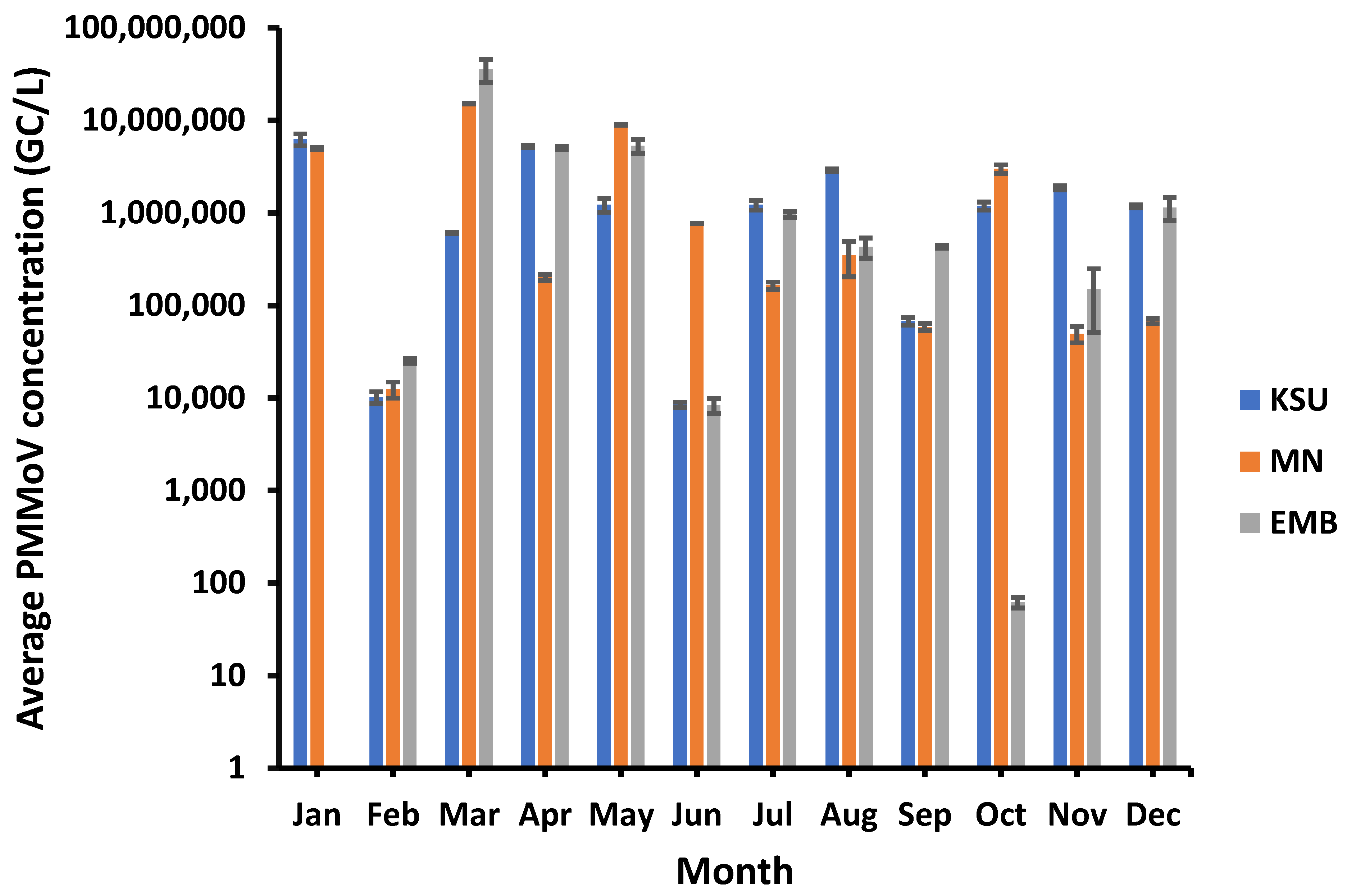
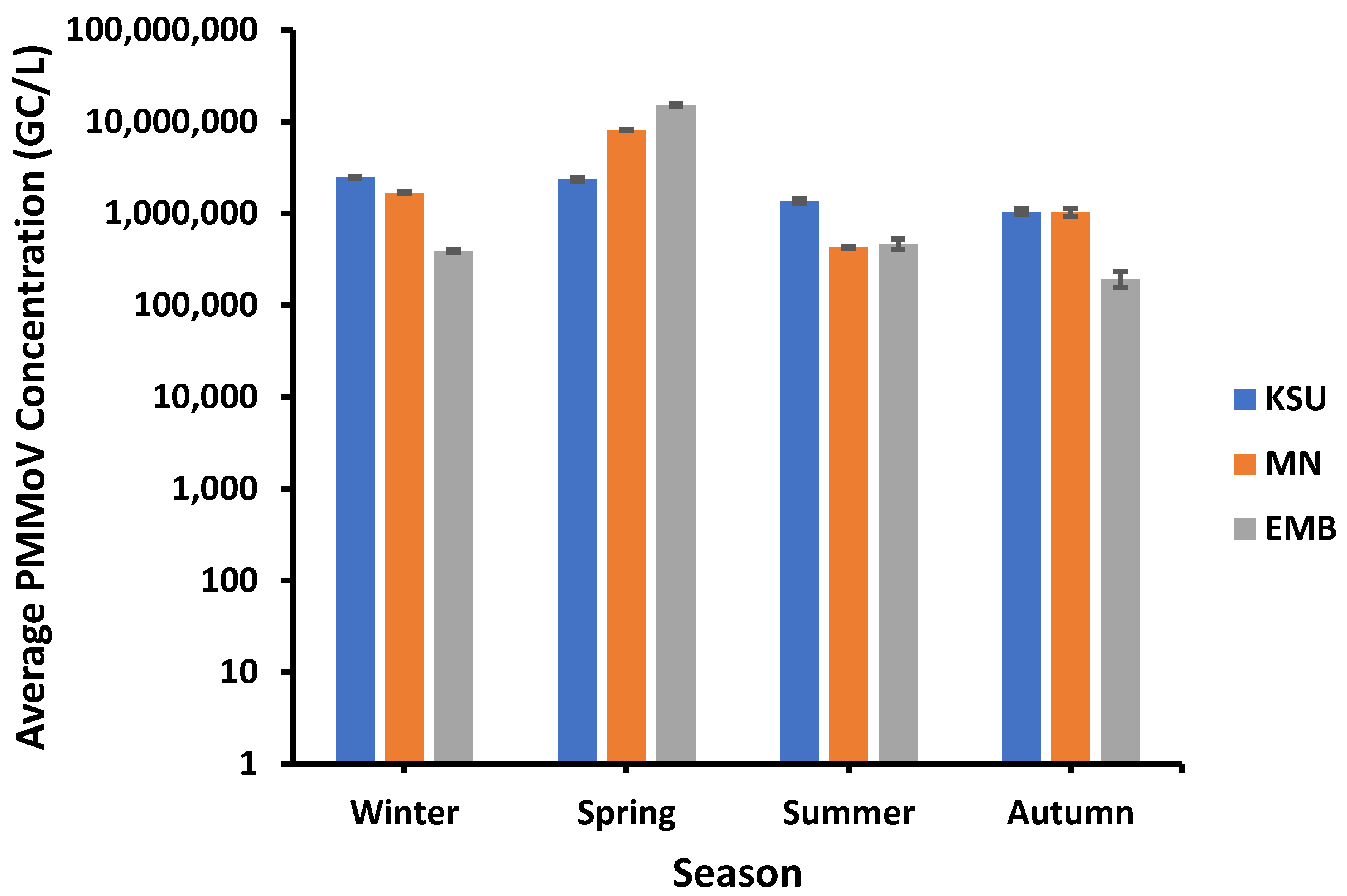

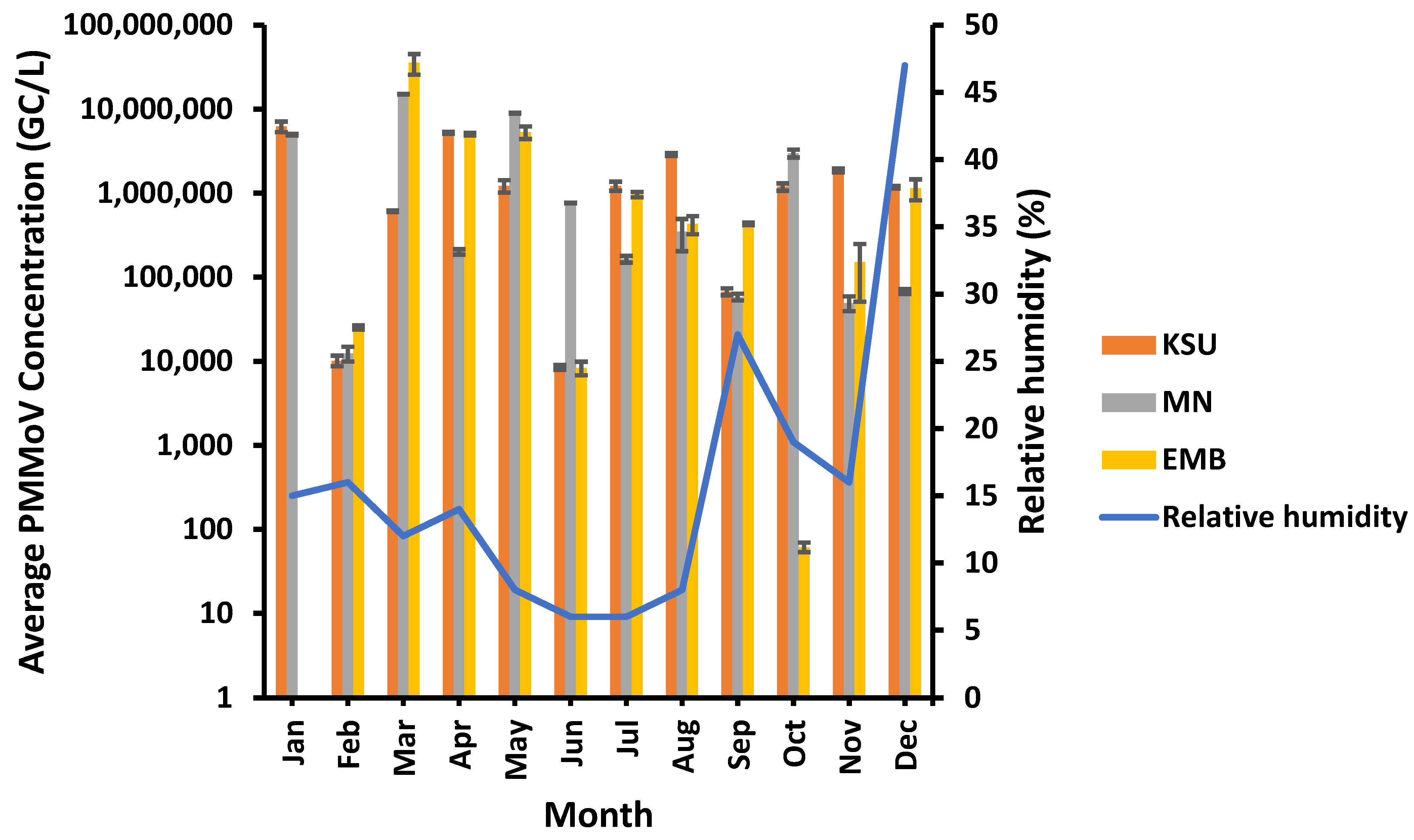
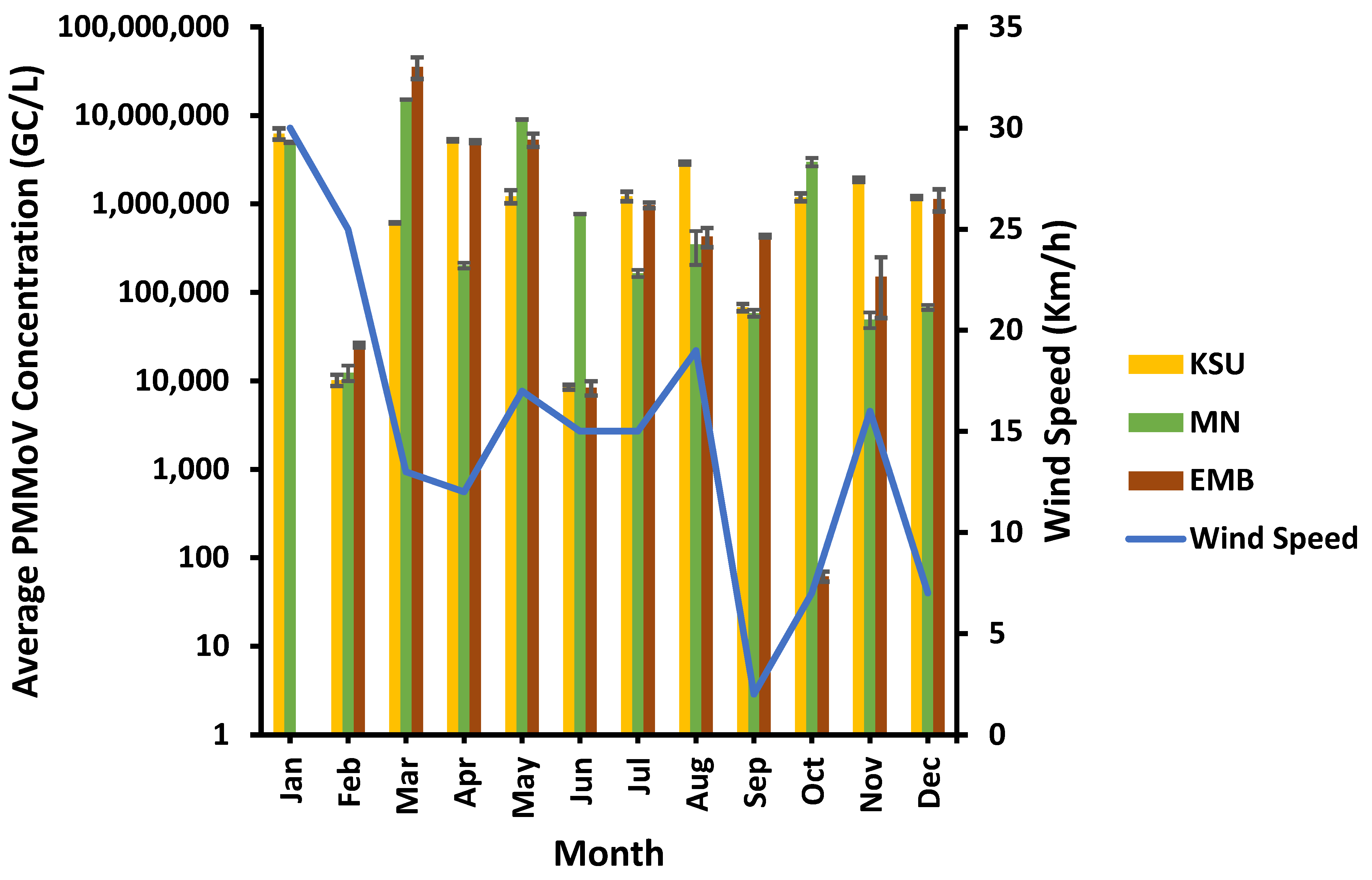
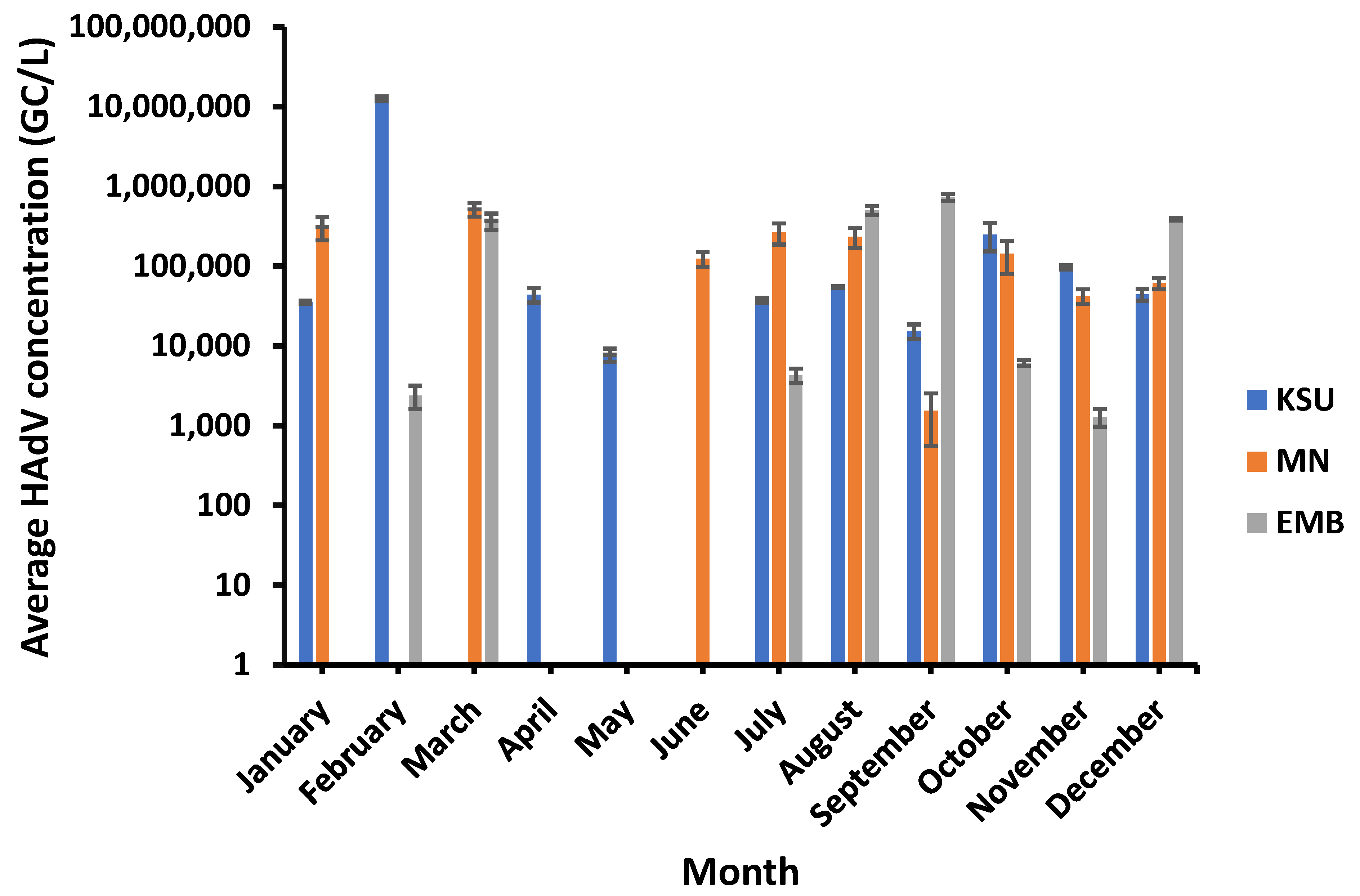
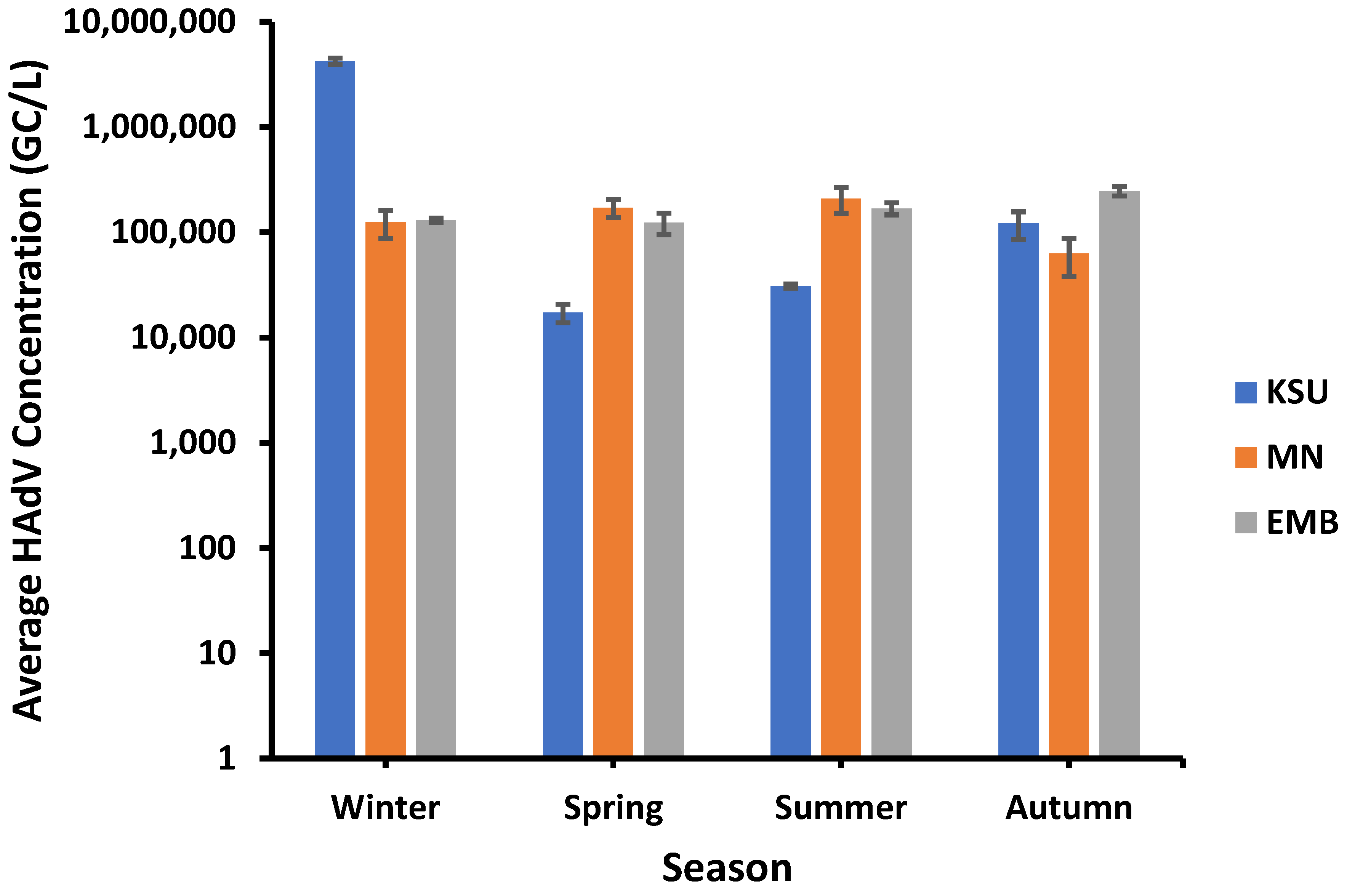
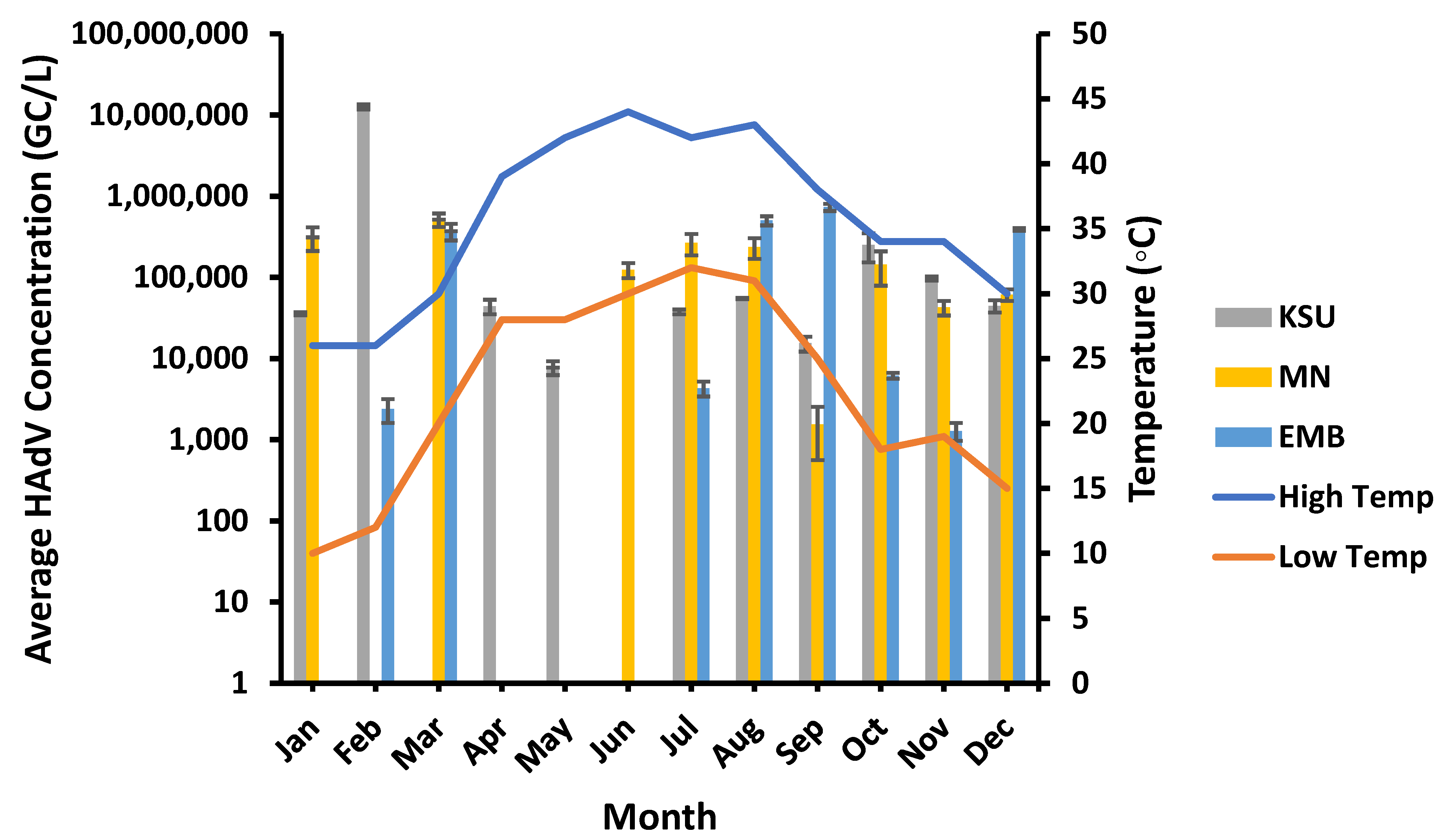
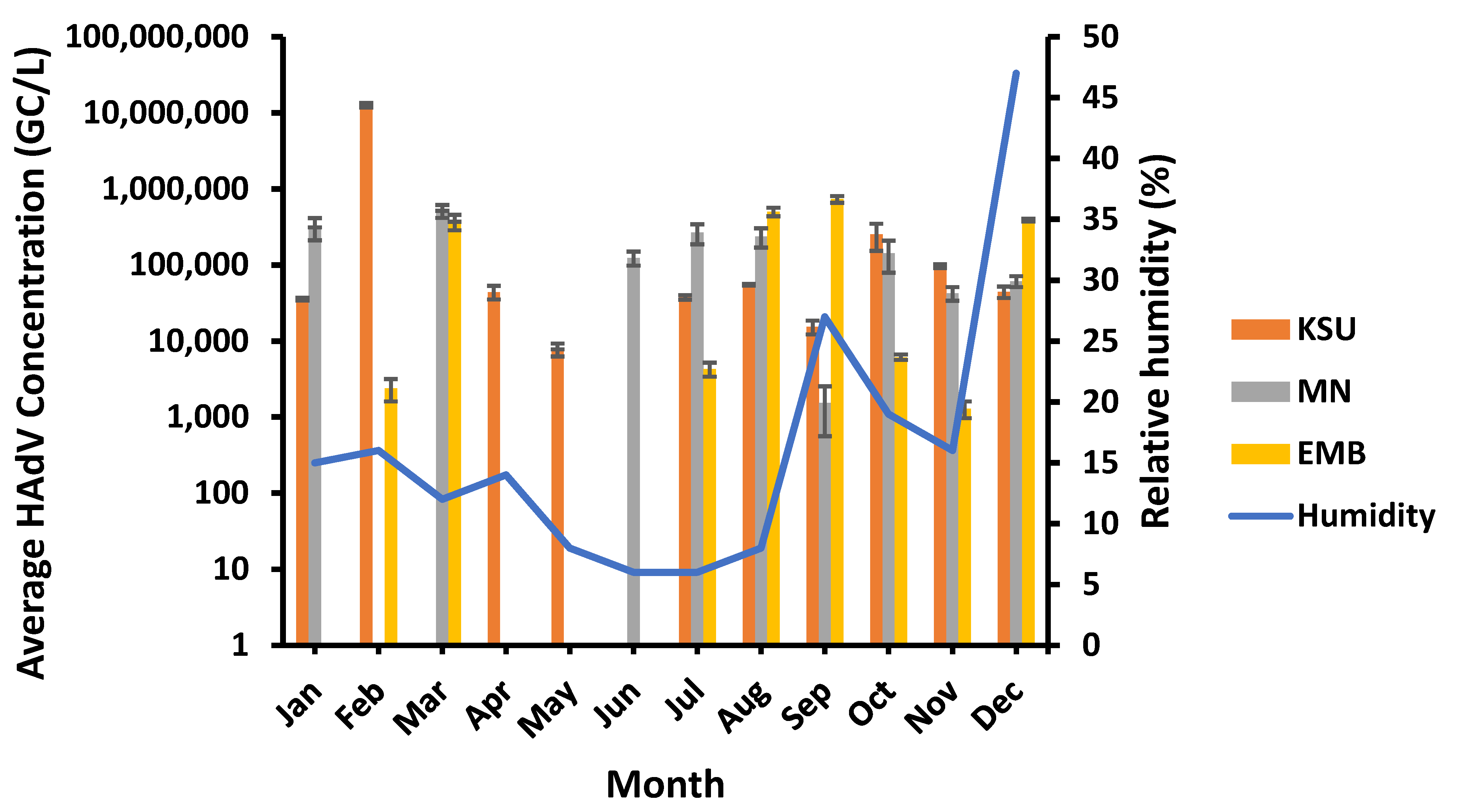
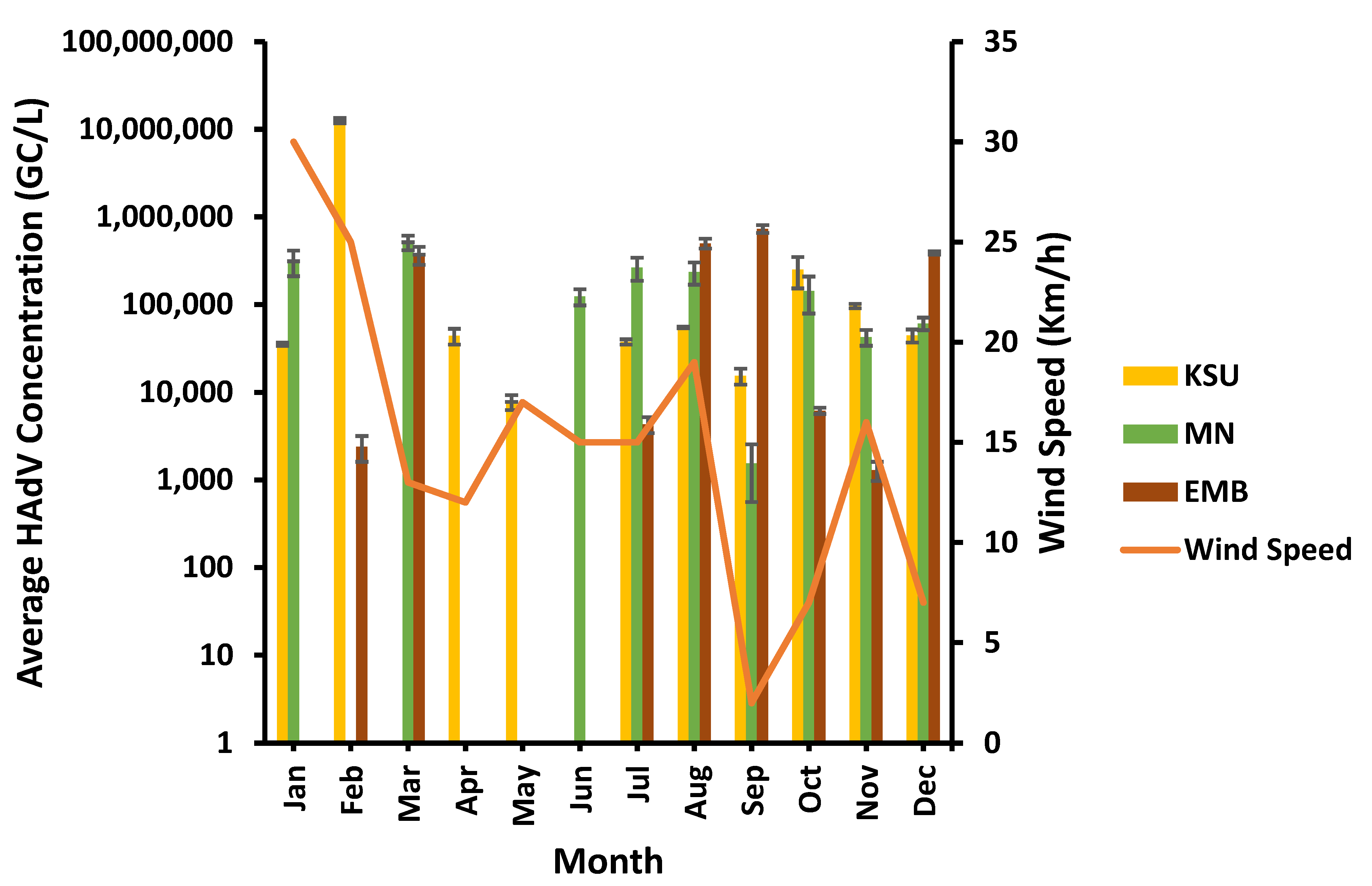
| Function | Primer/Probe | Sequence (5′–3′) | Reference |
|---|---|---|---|
| Forward primer | PMMV-FP1-rev | GAGTGGTTTGACCTTAACGTTTGA | [13] |
| Reverse primer | PMMV-RP1 | TTGTCGGTTGCAATGCAAGT | |
| TaqMan probe | PMMV-Probe1 | FAM-CCTACCGAAGCAAATG-BHQ1 |
| Environmental Factor | Location | R2 | RMSE | Equation |
|---|---|---|---|---|
| High temperature (TH) | EMB | 0.04 | 10,348,141.3 | GCMMoV = 15,109,644.77 − 309,151.929∗TH |
| MN | 0.043 | 4,873,605.45 | GCMMoV = 8,161,620.14 − 150,118.32∗TH | |
| KSU | 0.02 | 2,093,242.14 | GCMMoV = 3,392,512.85 − 44,380.8∗TH | |
| Low temperature (TL) | EMB | 0.0005 | 10,563,315.4 | GCMMoV = 4,741,219.53 − 29,462.4∗TL |
| MN | 0.014 | 4,947,281.5 | GCMMoV = 4,451,911.54 − 73,634.845∗TL | |
| KSU | 0.021 | 2,093,227.55 | GCMMoV = 2,660,847.35 −38,115.66∗TL | |
| Relative humidity (RH%) | EMB | 0.019 | 10,463,904.3 | GCMMoV = 6,057,248.5 − 122,104.49∗RH% |
| MN | 0.0577 | 4,836,788.65 | GCMMoV = 4,419,586.49 − 99,722.88∗RH% | |
| KSU | 0.0113 | 2,103,541.09 | GCMMoV = 2,112,875.73 − 18,759.48∗RH% | |
| Wind speed (WS) | EMB | 0.0087 | 10,519,736.4 | GCMMoV = 5,891,981.11 − 121,938.55∗WS |
| MN | 0.0117 | 4,953,237.27 | GCMMoV = 1,818,076.995 + 66,695.93∗WS | |
| KSU | 0.1976 | 1,895,054.97 | GCMMoV = 86,931.8 + 116,134.766∗TH |
| Environmental Factor | Location | R2 | RMSE | Equation |
|---|---|---|---|---|
| High temperature (TH) | EMB | 0.0032 | 271,615.12 | CHAdV = 87,417.63 + 2238.59∗TH |
| MN | 0.033 | 167,124.71 | CHAdV = 302,316.98 − 4501.29∗TH | |
| KSU | 0.217 | 3,362,628.5 | CHAdV = 10,235,239.19 − 256,157.73∗TH | |
| Low temperature (TL) | EMB | 0.0137 | 270,183.17 | CHAdV = 78,793.66 − 3961.216∗TL |
| MN | 0.003 | 169,765.37 | CHRV = 166,012.86 − 1085.46∗TL | |
| KSU | 0.184 | 3,431,201.9 | CHAdV = 5,630,067.79 − 202,886.02∗TL | |
| Relative humidity (RH%) | EMB | 0.19 | 244,722.61 | CHAdV = 7129.66 + 9905.02∗RH% |
| MN | 0.089 | 162,234.35 | CHAdV = 210,162.59 − 4230.42∗RH% | |
| KSU | 3.87 × 10−6 | 3,799,335.2 | CHAdV = 1,109,019.18 − 623.04∗RH% | |
| Wind speed (WS) | EMB | 0.25186 | 235,313.61 | CHAdV = 417,372.29 − 16,861.446∗WS |
| MN | 0.056 | 165,155.66 | CHAdV = 1.36 − 5.27× 10−2∗WS | |
| KSU | 0.25186 | 235,313.61 | CHAdV = 68,037.21 + 4970.8∗WS |
Disclaimer/Publisher’s Note: The statements, opinions and data contained in all publications are solely those of the individual author(s) and contributor(s) and not of MDPI and/or the editor(s). MDPI and/or the editor(s) disclaim responsibility for any injury to people or property resulting from any ideas, methods, instructions or products referred to in the content. |
© 2023 by the authors. Licensee MDPI, Basel, Switzerland. This article is an open access article distributed under the terms and conditions of the Creative Commons Attribution (CC BY) license (https://creativecommons.org/licenses/by/4.0/).
Share and Cite
Eifan, S.; Maniah, K.; Nour, I.; Hanif, A.; Yassin, M.T.; Al-Ashkar, I.; Abid, I. Pepper Mild Mottle Virus as a Potential Indicator of Fecal Contamination in Influents of Wastewater Treatment Plants in Riyadh, Saudi Arabia. Microorganisms 2023, 11, 1038. https://doi.org/10.3390/microorganisms11041038
Eifan S, Maniah K, Nour I, Hanif A, Yassin MT, Al-Ashkar I, Abid I. Pepper Mild Mottle Virus as a Potential Indicator of Fecal Contamination in Influents of Wastewater Treatment Plants in Riyadh, Saudi Arabia. Microorganisms. 2023; 11(4):1038. https://doi.org/10.3390/microorganisms11041038
Chicago/Turabian StyleEifan, Saleh, Khalid Maniah, Islam Nour, Atif Hanif, Mohamed Taha Yassin, Ibrahim Al-Ashkar, and Islem Abid. 2023. "Pepper Mild Mottle Virus as a Potential Indicator of Fecal Contamination in Influents of Wastewater Treatment Plants in Riyadh, Saudi Arabia" Microorganisms 11, no. 4: 1038. https://doi.org/10.3390/microorganisms11041038
APA StyleEifan, S., Maniah, K., Nour, I., Hanif, A., Yassin, M. T., Al-Ashkar, I., & Abid, I. (2023). Pepper Mild Mottle Virus as a Potential Indicator of Fecal Contamination in Influents of Wastewater Treatment Plants in Riyadh, Saudi Arabia. Microorganisms, 11(4), 1038. https://doi.org/10.3390/microorganisms11041038





